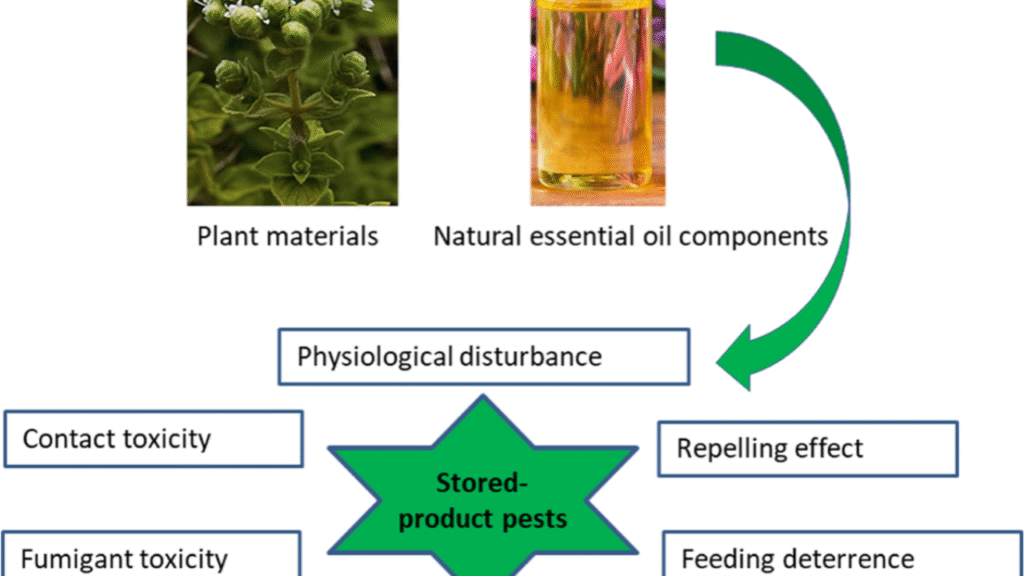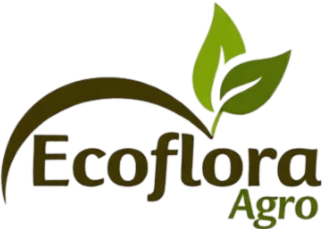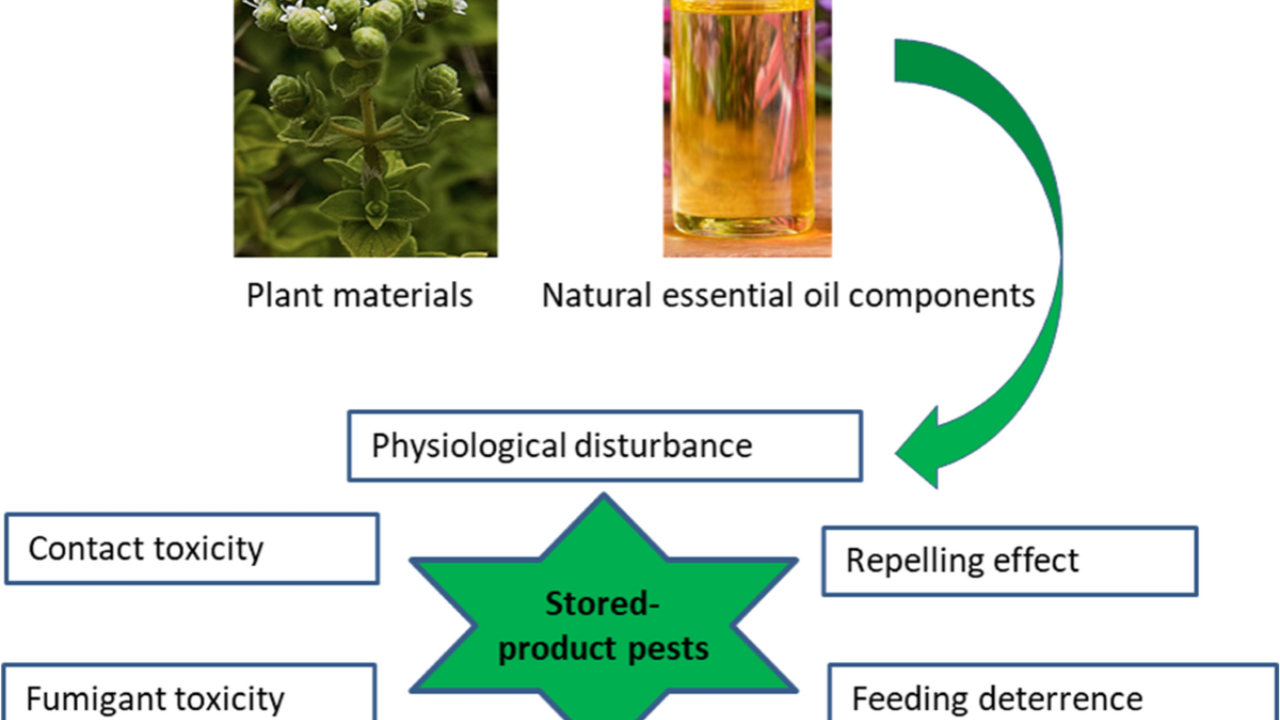
As chemical pesticide resistance grows and environmental concerns intensify, essential oils have emerged as a compelling alternative in pest control. Extracted from aromatic plants, these volatile oils are rich in bioactive compounds like terpenes, phenols, and aldehydes—each playing a role in deterring or killing insect pests. Whether derived from clove, peppermint, citronella, or eucalyptus, essential oils offer a natural, biodegradable option for eco-conscious crop protection.
However, despite their promising potential, these oils also come with a set of limitations that need to be carefully evaluated for commercial-scale farming. This article takes a balanced look at the pros and cons of using essential oils as natural insecticides.
Overview Table: Essential Oils in Pest Management
| Essential Oil | Main Active Components | Common Targets | Application Mode | Persistence | Environmental Risk |
|---|---|---|---|---|---|
| Clove | Eugenol | Aphids, beetles | Foliar spray | Low | Minimal |
| Citronella | Citral, Geraniol | Mosquitoes, moths | Vapor/spray | Very low | Minimal |
| Peppermint | Menthol, Menthone | Ants, spiders, mites | Spray/repellent | Moderate | Minimal |
| Eucalyptus | 1,8-Cineole, Terpineol | Whiteflies, weevils | Spray/fumigant | Low | Minimal |
| Rosemary | Camphor, Cineole | Thrips, mites | Oil emulsion | Low | Low |
What Makes Essential Oils Effective Insecticides?
Essential oils possess broad-spectrum insecticidal activity due to their high concentration of volatile secondary metabolites. Their modes of action include:
- Neurotoxic effects (e.g., eugenol in clove oil interferes with insect neural transmission)
- Respiratory disruption (many oils block spiracles)
- Feeding deterrents (citral in citronella masks attractants)
- Ovicidal and larvicidal properties (particularly menthol and cineole)
These oils act fast, sometimes within hours of application, and they degrade quickly—making them safe for the environment and non-target organisms.
Pros of Using Essential Oils as Insecticides
1. Eco-Friendly and Biodegradable
Essential oils degrade rapidly under sunlight and soil conditions, avoiding long-term residues or soil toxicity. This is ideal for organic farming systems.
2. Multiple Modes of Action
Unlike synthetic chemicals that often have a single active ingredient, essential oils contain a mix of compounds that act synergistically, making it harder for insects to develop resistance.
3. Low Toxicity to Humans and Pollinators
Most essential oils are safe for farm workers and less harmful to beneficial insects like bees, especially when applied with proper precautions.
4. Versatility
They can be used in multiple forms—as sprays, aerosols, repellents, and fumigants—depending on the pest and environment.
5. Natural Repellency
Essential oils don’t just kill pests—they also repel them. This dual function reduces infestation pressure over time.
Cons and Challenges in Using Essential Oils
1. Short Residual Activity
Essential oils evaporate quickly, especially in hot climates, reducing their long-term effectiveness. This may require frequent reapplication, increasing labor and cost.
2. Phytotoxicity Risks
High concentrations or poor formulation can cause leaf burn or stunted growth in sensitive crops.
3. Cost of Production
Extracting pure essential oils is cost-intensive, especially at commercial volumes, which makes large-scale usage economically challenging.
4. Standardization Issues
Due to natural variability in plant chemotypes, the same oil extracted from different sources can show inconsistent efficacy.
5. Limited Systemic Action
Essential oils generally lack systemic penetration, meaning they only work on contact or as repellents—not internally like synthetic neonicotinoids.
Comparative Table: Pros and Cons of Essential Oil Insecticides
| Feature | Advantage | Limitation |
|---|---|---|
| Environmental Impact | Safe, non-persistent | Short activity window |
| Application Frequency | Easy to apply via standard methods | Needs reapplication every few days |
| Safety Profile | Safe for users and pollinators | Can irritate skin or eyes in raw form |
| Resistance Management | Multi-component actions slow resistance | Not suitable for resistant pest outbreaks |
| Market Accessibility | Available in organic-certified forms | Expensive compared to synthetic pesticides |
Practical Applications in Agriculture
1. Greenhouse Protection:
Peppermint and eucalyptus oils are commonly used as sprays to deter aphids, mites, and whiteflies in greenhouse crops like tomatoes and cucumbers.
2. Grain Storage:
Clove and citronella oils are employed in fumigation to repel weevils and reduce insect damage during storage.
3. Fruit Orchards:
Citronella-based formulations are used in mango, guava, and citrus plantations to control moths and fruit flies during flowering and fruiting stages.
4. IPM Integration:
Essential oils serve as rotation tools in Integrated Pest Management (IPM) to reduce dependency on synthetic chemicals.
Tips for Effective Use
- Use emulsifiers or carriers like neem oil or soap to improve adhesion and penetration.
- Apply during cooler hours (early morning or evening) to reduce evaporation.
- Avoid direct sunlight exposure post-application.
- Perform a patch test on small sections before full-scale spraying to avoid phytotoxicity.
Conclusion
Essential oils present an exciting and sustainable avenue in natural insect control. Their versatility, safety, and low environmental footprint make them especially attractive for organic and smallholder farmers. However, their short-lived effectiveness, variable consistency, and cost barriers must be addressed through better formulations, encapsulation technologies, and integrated strategies.
As research continues and market demand for “clean farming” grows, essential oils may well become a core component of the eco-agrochemical toolbox—if used wisely and strategically.
3 Best One-Line FAQs
Q1: Can essential oils replace synthetic insecticides completely?
Not yet—though effective, essential oils need frequent application and work best in integrated pest systems.
Q2: Are essential oils safe for edible crops?
Yes, they leave no harmful residues and are commonly used in organic food production.
Q3: How long do essential oils remain active after spraying?
Typically 1–3 days, depending on temperature, sunlight, and formulation.

